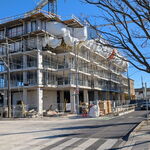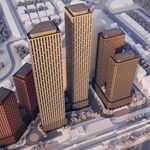Second_in_pie
Senior Member
^^ Canada line would only be slightly less expensive than subway, and frankly I wouldn't have a problem with it. The Canada Line cars have almost the exact same dimensions as subway, and the platforms were built so trains could be expanded close to subway length.
But then again, why would we buy a totally new rolling stock that's basically the same once we're already using subway extensively? Instead of making everyone else seem like subway freaks, you make yourself sound blatantly anti-subway. "Canada line isn't called a subway, so I'm totally okay with it even though it's basically the exact same thing as a subway."
As for Eglinton not coming anywhere near to 15 000 pphpd, I can't believe that at all. Eglinton West would intercept all the bus routes that now normally go to the B-D and I don't think it's too much to find even a 50% bus interception. Since the B-D gets well over 25 000 pphpd, that puts Eglinton dangerously close to capacity with Canada Line technology, and well over LRT. I know there's no definitive ridership study, but we're not going to get that form the TTC unless they get pressed to reevaluate the corridor.
Once that's done, or even before it's finished, they should start on the western portion to Pearson. It wouldn't take much more time than a LRT, but it'd be much, much more useful. If they really need to alleviate bus traffic on Eglinton (either east or west) before the Subway's extended, they could just paint some bus lanes on the quite large road. It's in no way a better service than LRT, but it'll increase speeds and allow busses to operate more efficiently while the subway gets built/extended.
But then again, why would we buy a totally new rolling stock that's basically the same once we're already using subway extensively? Instead of making everyone else seem like subway freaks, you make yourself sound blatantly anti-subway. "Canada line isn't called a subway, so I'm totally okay with it even though it's basically the exact same thing as a subway."
As for Eglinton not coming anywhere near to 15 000 pphpd, I can't believe that at all. Eglinton West would intercept all the bus routes that now normally go to the B-D and I don't think it's too much to find even a 50% bus interception. Since the B-D gets well over 25 000 pphpd, that puts Eglinton dangerously close to capacity with Canada Line technology, and well over LRT. I know there's no definitive ridership study, but we're not going to get that form the TTC unless they get pressed to reevaluate the corridor.
I think that starting with a Jane-Don Mills subway would be good, since it gives a quick relief to the central part of Eglinton, which is where the big bus bottlenecks and low speeds are.Fresh Start said:Arguably an Eglinton subway line would go well beyond the Weston-Leaside parameters. The airport is too important a destination to say that a bus connection to a subway being built primarily to provide a direct link between it and the rest of the city is suffived enough. I'd also think a one-kilometre extension east from Leslie to Don Mills is inconsequential especially when elevated overlooking Lord Seaton Park is a possibility.
Once that's done, or even before it's finished, they should start on the western portion to Pearson. It wouldn't take much more time than a LRT, but it'd be much, much more useful. If they really need to alleviate bus traffic on Eglinton (either east or west) before the Subway's extended, they could just paint some bus lanes on the quite large road. It's in no way a better service than LRT, but it'll increase speeds and allow busses to operate more efficiently while the subway gets built/extended.




